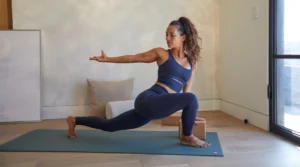In a world buzzing with stress and endless to-do lists, finding a mindfulness practice that truly resonates can feel like searching for a needle in a haystack. You’ve likely heard about meditation—sitting still, quieting the mind, chasing that elusive inner peace. But have you considered breathwork? It’s like meditation’s lively, oxygen-fueled cousin, offering a dynamic and accessible way to transform your mental, physical, and emotional health. As someone who’s tried both (and fumbled through many a meditation session), I’ve found breathwork to be a game-changer—fast, fun, and profoundly effective. In this article, we’ll dive into 10 compelling reasons why breathwork might just be the practice you’ve been searching for, outshining meditation in ways that might surprise you. Let’s take a deep breath and explore why consciously controlling your breath could be your ticket to a healthier, happier you.
What Is Breathwork, Anyway?
Breathwork involves intentional breathing techniques to enhance physical, mental, and emotional well-being. Unlike meditation, which often focuses on observing thoughts, breathwork actively engages your respiratory system to create immediate shifts in your body and mind. From ancient pranayama to modern holotropic breathing, it’s a practice rooted in centuries of wisdom, now backed by science.
Why It’s Gaining Traction
Breathwork’s popularity is soaring, with everyone from athletes to CEOs embracing its benefits. It’s not just a trend; studies show it reduces stress and boosts energy in ways meditation sometimes can’t match. Think of it as a shortcut to calm that doesn’t require years of practice to feel results.
Reason 1: Breathwork Is More Fun Than Sitting Still
Let’s be honest—meditation can feel like watching paint dry for some of us. Sitting cross-legged, trying to silence a brain that’s screaming about tomorrow’s deadlines, isn’t everyone’s cup of tea. Breathwork, on the other hand, is dynamic, often music-driven, and lets you lie down comfortably. It’s like trading a stuffy lecture hall for a dance party with your breath.
The Joy of Active Participation
Unlike meditation’s passive observation, breathwork invites you to engage actively. Techniques like the Two-Part Breath or Box Breathing feel like a workout for your lungs, making sessions energizing and, dare I say, fun. You’re not just sitting there—you’re riding the rhythm of your breath, which keeps you hooked.
Reason 2: Immediate Results You Can Feel
Meditation often requires months to notice benefits, leaving beginners wondering if they’re “doing it right.” Breathwork delivers instant feedback. The first time I tried diaphragmatic breathing, my racing heart slowed, and a wave of calm washed over me within minutes. It’s like flipping a switch for relaxation.
No Guesswork Required
With breathwork, the physical sensations—tingling hands, a lighter chest—are undeniable proof it’s working. This immediate feedback builds confidence and keeps you coming back, unlike meditation’s sometimes elusive progress. Studies confirm breathwork’s rapid stress reduction, making it a go-to for quick relief.
Reason 3: Physical Health Benefits Galore
While meditation soothes the mind, breathwork is a full-body workout. It strengthens your lungs, boosts circulation, and even alkalizes your body by flooding it with oxygen. As someone with a history of shallow breathing, I was amazed at how breathwork improved my energy and lung capacity.
From Lungs to Immunity
Research highlights breathwork’s ability to enhance respiratory function and immunity, especially vital in a post-COVID world. Unlike meditation, which primarily targets mental health, breathwork’s physical benefits—like lower blood pressure and better lung health—make it a holistic powerhouse.
Reason 4: Emotional Release Without the Therapy Couch
Breathwork can feel like a therapy session without the hefty bill. Techniques like holotropic breathwork can unlock suppressed emotions, offering a cathartic release. I once cried during a session—not out of sadness, but from letting go of stress I didn’t know I was carrying.
A Safe Space for Feelings
Unlike meditation, which asks you to observe emotions passively, breathwork actively processes them. It’s like giving your heart permission to let go. Studies suggest breathwork facilitates emotional regulation, making it ideal for those navigating trauma or stress.
Reason 5: Energy and Clarity on Demand
Need a pick-me-up without the coffee jitters? Breathwork delivers. Techniques like Kapalabhati Breath energize your body and clear mental fog faster than a double espresso. I’ve used it before big meetings to sharpen my focus and feel unstoppable.
No Caffeine Crash Here
Unlike meditation’s gradual clarity, breathwork’s oxygen surge provides instant energy. Research shows it boosts vitality and cognitive function, making it perfect for busy folks who need a quick mental reset without the crash.
Reason 6: Less Overwhelming for Beginners
Meditation can feel intimidating—sitting still, wrestling with a wandering mind, hoping for enlightenment. Breathwork is simpler: just follow the breathing pattern. When I started, the clear instructions of Box Breathing made me feel like a pro from day one.
Guided and Accessible
Breathwork’s structured approach, often guided by apps or instructors, makes it beginner-friendly. You don’t need to master mindfulness to feel results. Its accessibility is why many, including me, stick with it over meditation’s steeper learning curve.
Reason 7: A Natural High Without Risks
Breathwork can mimic the euphoric effects of psychedelics—legally and safely. Renowned psychiatrist Stanislav Grof studied holotropic breathwork for decades, noting its ability to induce altered states of consciousness. My first session felt like a gentle, natural high, leaving me uplifted and connected.
Psychedelic Vibes, No Substances
Unlike meditation, which rarely offers such intense experiences, breathwork can transport you to profound emotional and spiritual states. It’s a safe, accessible way to explore your inner world without the risks of plant medicine.
Reason 8: Strengthens Your Lungs and Body
In a world where respiratory health is paramount, breathwork shines. It’s like a gym session for your lungs, improving capacity and efficiency. As someone who struggled with post-viral fatigue, I credit breathwork for helping me breathe deeper and feel stronger.
Beyond Mental Benefits
Meditation doesn’t directly target physical health like breathwork does. Studies show breathwork enhances lung function and boosts immunity, making it a vital tool for anyone looking to fortify their body against illness.
Reason 9: Fits Busy Lifestyles
Who has time for hour-long meditation sessions? Breathwork’s short, potent sessions—sometimes just 5 minutes—fit seamlessly into hectic schedules. I often sneak in a quick 4-7-8 breathing session between meetings, and it’s a game-changer.
Quick and Effective
Unlike meditation, which often demands longer sessions for noticeable effects, breathwork’s efficiency is unmatched. Research confirms even brief sessions can reduce stress and boost focus, perfect for those juggling work, family, and life.
Reason 10: Connects You to Something Bigger
Breathwork isn’t just about oxygen—it’s a bridge to your spirit. Experts like Dan Brulé call it a link to your higher self. During one session, I felt an overwhelming sense of love and connection to the world, something meditation rarely evoked so quickly.
Spiritual Awakening Made Simple
While meditation can foster spiritual growth over time, breathwork’s immediate connection to source energy is profound. It’s like a direct line to your soul, offering a sense of purpose and unity in just one session.
Comparing Breathwork and Meditation: A Quick Glance
To help you decide, here’s a side-by-side comparison of breathwork and meditation based on key factors.
| Aspect | Breathwork | Meditation |
|---|---|---|
| Focus | Active breath control for immediate physiological shifts | Passive observation for mental clarity and long-term mindfulness |
| Benefits | Stress relief, energy boost, emotional release, improved lung health | Stress reduction, improved focus, self-awareness, emotional stability |
| Time Commitment | Effective in short 5–15 minute sessions | Often requires 20–60 minutes for noticeable effects |
| Accessibility | Beginner-friendly with guided instructions | Can be challenging for beginners due to mental focus required |
| Physical Engagement | High—engages respiratory and circulatory systems | Low—primarily mental, with minimal physical involvement |
Pros and Cons of Each Practice
Breathwork Pros:
- Immediate, tangible results
- Fun and engaging
- Boosts physical health
- Fits busy schedules
- Facilitates emotional release
Breathwork Cons:
- Some techniques require guidance
- Intense sessions may feel overwhelming initially
Meditation Pros:
- Builds long-term mindfulness
- Enhances self-awareness
- Widely accessible resources
- Calms the mind effectively
Meditation Cons:
- Slower results
- Can feel boring or difficult for beginners
How to Get Started with Breathwork
Ready to give breathwork a try? Here’s how to dive in:
- Start Simple: Try Box Breathing (inhale 4 seconds, hold 4, exhale 4, hold 4) or 4-7-8 Breathing (inhale 4, hold 7, exhale 8).
- Find Guidance: Apps like Othership or Breathwrk offer guided sessions. Local classes or online courses are also great options.
- Create a Space: Find a quiet spot, use a comfy chair or mat, and maybe add some calming music.
- Combine with Meditation: Start with 5 minutes of breathwork to ease into a meditative state for deeper mindfulness.
For the best tools, check out apps like Insight Timer for guided breathwork or visit sites like SOMA Breath for expert-led sessions.
People Also Ask (PAA)
Is breathwork better than meditation?
It depends on your goals. Breathwork offers immediate physical and emotional benefits, making it ideal for quick stress relief and energy boosts. Meditation excels at building long-term mindfulness and self-awareness. Try both to see what resonates.
Can you combine breathwork and meditation?
Absolutely! Start with 5–10 minutes of breathwork to calm your body, then transition into meditation for deeper focus. This synergy enhances both practices, creating a balanced mindfulness routine.
What are the best breathwork techniques for beginners?
Box Breathing, 4-7-8 Breathing, and Diaphragmatic Breathing are beginner-friendly. They’re simple, guided, and deliver quick results. Apps like Breathwrk or online tutorials can help you master them.
Is breathwork safe for everyone?
Most people can practice breathwork safely, but those with respiratory or heart conditions should consult a doctor. Intense techniques like holotropic breathwork require professional guidance to avoid dizziness or discomfort.
FAQ Section
Q: How long does it take to see results from breathwork?
A: Unlike meditation, breathwork often delivers results in your first session. You may feel calmer, more energized, or emotionally lighter within minutes. Consistent practice enhances these benefits over time.
Q: Can breathwork replace meditation entirely?
A: It depends on your needs. Breathwork is great for immediate relief and physical health, while meditation builds long-term mindfulness. Combining both often yields the best results.
Q: Where can I learn breathwork?
A: Apps like Othership, Breathwrk, or Insight Timer offer guided sessions. Websites like Frequency Breathwork or local wellness centers provide classes and certifications.
Q: Is breathwork scientifically proven?
A: Yes, studies show breathwork reduces stress, lowers cortisol, and improves respiratory and cardiovascular health. Research in journals like Scientific Reports confirms its efficacy for mental and physical well-being.
Q: What’s the best time to practice breathwork?
A: Morning sessions energize you for the day, while evening practice promotes relaxation and better sleep. Even a 5-minute session during a lunch break can reset your mind.
Final Thoughts: Why Breathwork Might Be Your New Go-To
Breathwork isn’t just a practice—it’s a lifeline in our chaotic world. Its immediate effects, physical benefits, and sheer accessibility make it a compelling choice over meditation for many. Whether you’re seeking stress relief, a burst of energy, or a deeper connection to yourself, breathwork delivers in ways that feel vibrant and alive. As someone who’s felt the transformative power of a single breathwork session, I encourage you to give it a try. Start with a simple technique, find a quiet corner, and let your breath guide you to a brighter, calmer you. Ready to breathe your way to better health? Your lungs—and your soul—will thank you.








